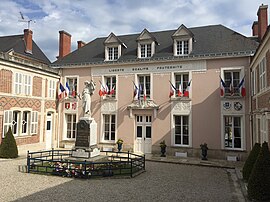Hautvillers | |
|---|---|
 The town hall in Hautvillers | |
| Coordinates: 49°05′06″N 3°56′40″E / 49.085°N 3.9444°E | |
| Country | France |
| Region | Grand Est |
| Department | Marne |
| Arrondissement | Épernay |
| Canton | Épernay-1 |
| Intercommunality | Grande Vallée de la Marne |
| Government | |
| • Mayor (2020–2026) | Silvère Pierrot[1] |
| Area 1 | 11.77 km2 (4.54 sq mi) |
| Population (2021)[2] | 649 |
| • Density | 55/km2 (140/sq mi) |
| Time zone | UTC+01:00 (CET) |
| • Summer (DST) | UTC+02:00 (CEST) |
| INSEE/Postal code | 51287 /51160 |
| Elevation | 195 m (640 ft) |
| 1 French Land Register data, which excludes lakes, ponds, glaciers > 1 km2 (0.386 sq mi or 247 acres) and river estuaries. | |
Hautvillers (French pronunciation: [ovile]) is a commune in the Marne department in north-eastern France.
The Abbey of St. Peter which existed here until the French Revolution was the home of the famous Dom Perignon, a Benedictine monk whose work in wine-making helped to develop champagne. Because of the region's testimony to the development of champagne and unique agro-industrial system, the nearby vineyards, harvest huts, presses, and cellars were inscribed on the UNESCO World Heritage List in 2015 as part of the Champagne hillsides, houses and cellars site.[3] The underground cellars, used for storing and fermenting the champagne, were built in the late 17th century and are some of the first cellars specifically dedicated to storing champagne.[3]

See also
[edit]References
[edit]- ^ "Répertoire national des élus: les maires" (in French). data.gouv.fr, Plateforme ouverte des données publiques françaises. 13 September 2022.
- ^ "Populations légales 2021" (in French). The National Institute of Statistics and Economic Studies. 28 December 2023.
- ^ a b "Champagne Hillsides, Houses and Cellars". UNESCO World Heritage Centre. United Nations Educational, Scientific, and Cultural Organization. Retrieved 12 December 2021.




Well, that’s interesting to know that Psilotum nudum are known as whisk ferns. Psilotum nudum is the commoner species of the two. While the P. flaccidum is a rare species and is found in the tropical islands. Both the species are usually epiphytic in habit and grow upon tree ferns. These species may also be terrestrial and grow in humus or in the crevices of the rocks.
View the detailed Guide of Psilotum nudum: Detailed Study Of Psilotum Nudum (Whisk Fern), Classification, Anatomy, Reproduction